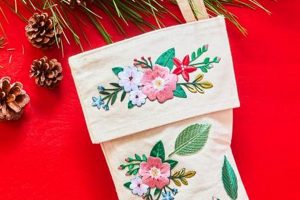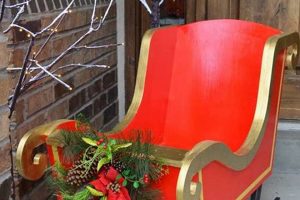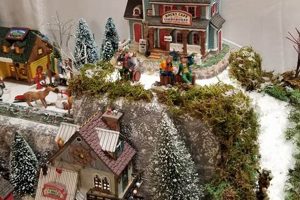Handmade holiday greetings, specifically those employing water-based paints and designed for the Christmas season, represent a personalized form of artistic expression. These cards are typically created by individuals for their own use or as gifts, differing from mass-produced commercial options. A tangible example includes a card featuring a painted robin perched on a snow-covered branch, meticulously rendered with varying shades of red and brown watercolour paints.
Creating personalized holiday cards offers several advantages. It fosters creativity, provides a unique and heartfelt way to connect with recipients, and can be a cost-effective alternative to purchasing pre-made cards. The practice of sending handcrafted seasonal greetings has historical roots in the Victorian era, when the exchange of ornate cards became a popular tradition. This tradition has evolved, with modern iterations often incorporating diverse artistic techniques and materials.
The subsequent sections will explore essential materials for crafting these greetings, practical watercolour techniques suited for the task, and a range of design ideas to inspire unique and memorable creations. This will facilitate the production of distinctive and aesthetically pleasing cards.
Guidance for Watercolour Christmas Card Creation
The following recommendations aim to enhance the creation of handmade holiday greetings. Adherence to these suggestions can improve the overall quality and aesthetic appeal of the finished product.
Tip 1: Select Appropriate Paper: Opt for watercolour paper specifically designed to withstand water saturation. A weight of at least 140 lb (300 gsm) is recommended to prevent warping or buckling during the painting process. Consider cold-pressed paper for texture or hot-pressed for smoother details.
Tip 2: Employ High-Quality Pigments: Invest in artist-grade watercolours for vibrant, lightfast colors. Student-grade paints may exhibit lower pigment concentration, resulting in less saturated and potentially less permanent results. Select a curated palette of essential colours that can be mixed to achieve a wide range of hues.
Tip 3: Master Basic Watercolour Techniques: Practice foundational techniques such as wet-on-wet, wet-on-dry, and dry brushing. Wet-on-wet creates soft, blended effects, ideal for backgrounds. Wet-on-dry provides greater control and definition. Dry brushing adds texture and detail.
Tip 4: Utilize Masking Fluid Strategically: Employ masking fluid to preserve white areas or intricate details. Apply it to areas that require protection from subsequent washes. Ensure the masking fluid is completely dry before applying paint, and remove it carefully once the paint is dry.
Tip 5: Incorporate Fine-Line Detailing: Use fine-tipped watercolour brushes or watercolour pencils to add intricate details and outlines. This can enhance the realism and visual interest of the artwork. Consider using a waterproof fineliner for permanent details.
Tip 6: Plan the Composition: Before commencing painting, sketch a preliminary design to establish the composition and arrangement of elements. This ensures a balanced and visually appealing card design. Consider the placement of the focal point and the overall flow of the artwork.
Tip 7: Allow Adequate Drying Time: Ensure each layer of watercolour is completely dry before applying subsequent layers. Rushing the drying process can lead to muddy colours and unintended bleeding. Utilize a hairdryer on a low setting to accelerate the drying time if necessary.
Adherence to these recommendations can contribute to the production of professional-looking and personalized holiday greetings. Careful material selection, technique mastery, and thoughtful planning are essential for successful execution.
The following section will address common challenges encountered during the card-making process and provide practical solutions for overcoming them.
1. Paper Quality
The selection of appropriate paper constitutes a foundational element in the creation of “diy watercolour christmas cards”. Paper quality directly affects the watercolour application’s success, impacting color vibrancy, blending capabilities, and the structural integrity of the final card. Inferior paper, characterized by low weight or inadequate sizing, can lead to unwanted buckling, bleeding, and feathering of pigments. Conversely, paper specifically designed for watercolour, typically weighing at least 140 lb (300gsm) and surface-sized, provides optimal absorbency, minimizing these adverse effects and ensuring crisper, more controlled washes.
The impact of paper quality extends beyond the painting process itself. A sturdier paper stock contributes to the card’s overall durability, rendering it less susceptible to damage during handling and mailing. Furthermore, the surface texture of the paper influences the visual aesthetic of the finished card. Cold-pressed paper, with its textured surface, imparts a subtle grain to the watercolour application, lending a rustic or handcrafted appearance. Hot-pressed paper, smoother in texture, allows for finer detailing and a more polished result. The choice between these options dictates the final visual impression conveyed by the greeting.
In summary, paper quality is not merely a technical consideration but an integral determinant of the artistic outcome and perceived value of handmade holiday greetings. Its selection warrants careful consideration, aligning with the intended aesthetic and ensuring the creation of durable and visually appealing cards. Ignoring this facet can negate the benefits of high-quality pigments and meticulous technique, resulting in a compromised final product.
2. Pigment Selection
Pigment selection represents a crucial determinant in the visual impact and longevity of handmade watercolour holiday greetings. The inherent qualities of chosen pigments influence color vibrancy, lightfastness, and the overall aesthetic appeal of the finished card. Proper consideration of pigment characteristics elevates the quality and enduring nature of the artwork.
- Color Vibrancy and Saturation
The concentration and quality of pigments directly correlate with the intensity and saturation of colors achieved. Artist-grade watercolours, possessing higher pigment loads than student-grade alternatives, yield more vivid and nuanced hues. The selection of hues appropriate for the holiday season is also important, with reds, greens, and blues, for example, contributing to festive imagery.
- Lightfastness and Archival Quality
Lightfastness, the resistance of pigments to fading upon exposure to light, is paramount for ensuring the longevity of watercolour paintings. Pigments with poor lightfastness ratings will degrade over time, diminishing the visual impact of the card. Opting for pigments with high lightfastness ratings (indicated on pigment information sheets) safeguards the enduring quality of the artwork. Real-world examples include the avoidance of fugitive dyes which fade quickly, rendering the card dull over a short timeframe.
- Transparency and Opacity
The transparency or opacity of a pigment influences its layering capabilities and the depth of color achieved. Transparent pigments allow light to pass through multiple layers, creating luminous effects and subtle gradations. Opaque pigments provide greater coverage and are useful for creating bold statements or blocking out areas. A judicious combination of transparent and opaque pigments enhances the visual complexity and dimensionality of the card.
- Mixing Properties and Compatibility
The mixing properties of pigments dictate their behavior when blended with other colors. Certain pigments may react unfavorably, resulting in muddy or undesirable hues. Understanding the compatibility of pigments and practicing color mixing techniques are essential for achieving desired color harmonies and avoiding unexpected results. This requires careful consideration of the pigment’s chemical composition and its interaction with other pigments in the watercolour palette.
The attributes of chosen pigments directly impact the visual characteristics and long-term preservation of custom holiday greetings. Informed selection, considering color vibrancy, lightfastness, transparency, and mixing properties, ensures the production of distinctive and durable cards reflecting both artistic skill and thoughtful material selection.
3. Technique Mastery
Proficiency in watercolour techniques is indispensable for creating visually compelling and technically sound “diy watercolour christmas cards.” The successful execution of watercolour designs relies heavily on a fundamental understanding and skillful application of various methods. Without technique mastery, the potential for creative expression is significantly diminished, resulting in cards that may lack the desired level of detail, vibrancy, or overall aesthetic appeal. For example, attempting to paint a realistic snow scene without mastering wet-on-wet blending can lead to harsh edges and an unnatural representation of soft textures. Similarly, a lack of control in dry-brushing can result in coarse, uneven textures instead of delicate details.
Specific watercolour techniques, such as layering, glazing, lifting, and masking, each contribute unique effects to the final artwork. Layering, the application of multiple washes of diluted colour, builds depth and richness. Glazing involves applying transparent washes over dried layers to modify hue and tone. Lifting removes paint from the paper, creating highlights or textures. Masking fluid preserves white areas or intricate details during the painting process. The adept use of these techniques enables the creation of complex and nuanced designs suitable for festive themes. One application could involve layering various washes of green and brown to create a complex, textured pine tree, using masking fluid to preserve highlights that will later represent snow.
In conclusion, technique mastery directly influences the artistic merit and technical quality of handmade watercolour holiday greetings. The ability to control the medium, manipulate colour, and create desired effects enhances the artist’s capacity to translate creative visions into tangible works of art. While artistic talent is valuable, technical proficiency provides the necessary foundation for consistent and high-quality card creation. Ultimately, mastering these skills allows the creator to produce greetings that are not only visually appealing but also reflect a deep understanding of the medium and its capabilities.
4. Design Inspiration
Design inspiration serves as the catalyst for translating creative concepts into tangible “diy watercolour christmas cards”. Its role extends beyond mere aesthetic appeal, encompassing thematic relevance, technical feasibility, and the conveyance of intended sentiments. Without effective design inspiration, handmade cards risk appearing generic or lacking a cohesive artistic vision.
- Seasonal Themes and Motifs
Seasonal themes and motifs, drawn from traditional Christmas imagery, provide a fundamental source of design inspiration. Snowflakes, evergreen trees, holly berries, and representations of Santa Claus are frequently employed to evoke a sense of holiday spirit. Variations in the artistic interpretation of these motifs, such as abstract renderings of snowflakes or stylized depictions of reindeer, allow for personalized expression. A practical example involves using watercolour techniques to create a minimalist evergreen tree silhouette with subtle washes of green and gold, deviating from more conventional, detailed depictions.
- Nature-Inspired Elements
Nature-inspired elements offer a diverse range of design possibilities beyond explicitly seasonal themes. Winter landscapes, woodland creatures, and botanical illustrations provide opportunities for intricate watercolour applications. Examples include the depiction of a robin perched on a snow-covered branch, rendered with delicate watercolour washes to capture the bird’s texture and coloration, or the creation of a forest scene utilizing varying shades of green and brown to convey depth and perspective. These elements introduce a sense of organic beauty and can be tailored to reflect personal preferences.
- Calligraphic and Typographic Elements
Calligraphic and typographic elements augment the visual impact of handmade cards and convey personalized messages. Hand-lettered greetings, such as “Merry Christmas” or “Happy Holidays,” add a personal touch and complement the watercolour artwork. Variations in font styles, from elegant cursive to bold sans-serif, allow for diverse aesthetic expression. Examples include incorporating a hand-lettered quote within a watercolour wreath design or using typography to create a focal point within a minimalist landscape. Careful selection of font style and placement enhances the overall visual harmony of the card.
- Abstract and Geometric Designs
Abstract and geometric designs offer an alternative to traditional imagery, providing opportunities for innovative watercolour applications. Patterns composed of geometric shapes, abstract washes of colour, or non-representational forms can create visually striking and contemporary cards. Examples include using masking fluid to create geometric patterns before applying watercolour washes, resulting in clean lines and dynamic contrasts, or employing wet-on-wet techniques to create blended colour gradients within abstract compositions. These designs allow for experimentation with colour palettes and compositional arrangements, fostering unique and expressive results.
The integration of design inspiration into the creation of “diy watercolour christmas cards” transforms the process from a mere craft activity into a vehicle for artistic expression. Effective utilization of seasonal themes, nature-inspired elements, calligraphic additions, and abstract designs enables the production of unique and personalized holiday greetings that convey both aesthetic appeal and heartfelt sentiments. The thoughtful application of these elements elevates the quality and impact of the handmade cards, reflecting individual creativity and artistic skill.
5. Personalization Options
The capacity for individual expression is a key attribute of “diy watercolour christmas cards”. Customization transcends mere decoration, reflecting a deliberate effort to tailor the card to the recipient’s preferences and the sender’s unique message. This level of individualization elevates the card beyond a generic greeting, transforming it into a personalized token of affection and thoughtfulness.
- Recipient-Specific Imagery
The incorporation of imagery directly related to the card’s recipient constitutes a significant personalization strategy. This may include depictions of the recipient’s pets, hobbies, or significant landmarks. For example, a card for a gardening enthusiast could feature a watercolour illustration of their favorite flower, rendered in their preferred color palette. The inclusion of such specific details demonstrates a heightened level of attention and care, distinguishing the card from mass-produced alternatives.
- Hand-Lettered Messages
The addition of hand-lettered messages provides an opportunity to convey personalized sentiments in a visually distinctive manner. Rather than relying on printed text, the application of calligraphy or expressive handwriting lends a unique aesthetic and emotional weight to the greeting. A handwritten message can be tailored to reflect the specific relationship between sender and recipient, incorporating inside jokes, shared memories, or expressions of gratitude. The visual character of the handwriting itself contributes to the card’s overall artistic appeal.
- Color Palette Customization
The adaptation of the card’s color palette to suit the recipient’s aesthetic preferences is a subtle yet effective personalization technique. Understanding the recipient’s preferred colors and incorporating them into the watercolour design demonstrates a sensitivity to their individual tastes. A card for someone who favors cool tones might feature a palette of blues, greens, and silvers, while a card for someone with warmer preferences could incorporate reds, oranges, and golds. This tailoring of the color scheme enhances the card’s overall visual harmony and resonance with the recipient.
- Incorporation of Personal Symbols
The integration of personal symbols or motifs holds the potential to imbue the card with deeper meaning and emotional significance. This may involve incorporating symbols that represent shared experiences, cultural heritage, or personal values. For example, a card for a family celebrating a particular cultural tradition could feature a watercolour illustration of a related symbol. The inclusion of such symbols transforms the card into a personalized emblem of connection and shared identity, strengthening the emotional bond between sender and recipient.
These various facets of personalization contribute to the creation of “diy watercolour christmas cards” that are both aesthetically pleasing and deeply meaningful. By tailoring the imagery, messages, color palettes, and symbolic elements to reflect the unique characteristics of the recipient, the sender transforms a simple greeting into a cherished keepsake, fostering a stronger connection and conveying a more profound sense of care and thoughtfulness.
Frequently Asked Questions Regarding DIY Watercolour Christmas Cards
The following section addresses common inquiries pertaining to the creation of handmade watercolour holiday greetings, offering clarification on essential techniques, materials, and design considerations.
Question 1: What constitutes the optimal paper weight for watercolour Christmas cards?
The minimum recommended paper weight is 140 lb (300 gsm). Lighter paper stocks are prone to buckling and warping when exposed to water, compromising the visual quality of the finished card.
Question 2: Are artist-grade watercolours essential, or can student-grade paints suffice?
Artist-grade watercolours offer superior pigment concentration, lightfastness, and mixing properties. While student-grade paints may be suitable for practice, artist-grade paints are recommended for creating enduring and visually impactful cards.
Question 3: How can bleeding and feathering of watercolour pigments be effectively prevented?
Employing high-quality watercolour paper and allowing each layer of paint to dry completely before applying subsequent layers mitigates bleeding and feathering. Utilizing masking fluid can also protect specific areas from unintended colour spread.
Question 4: What is the purpose of masking fluid in watercolour card creation?
Masking fluid serves as a temporary barrier, preserving white areas or intricate details from subsequent washes of watercolour. It is applied to the designated areas, allowed to dry completely, and then carefully removed after the surrounding paint has dried.
Question 5: How can hand-lettering be effectively integrated into watercolour Christmas card designs?
Employing waterproof fineliner pens or watercolour pencils allows for precise and durable hand-lettering. Practicing calligraphic techniques and planning the placement of lettering within the overall composition enhances the visual harmony of the card.
Question 6: What methods can be employed to accelerate the drying time of watercolour paintings?
A hairdryer set on a low, cool setting can be used to expedite the drying process. However, caution must be exercised to avoid overheating the paper, which can cause buckling or pigment distortion.
The informed application of these techniques and materials ensures the production of aesthetically pleasing and durable handmade holiday greetings.
The subsequent section will present a conclusion summarizing the key considerations for crafting personalized watercolour Christmas cards.
Conclusion
The foregoing exploration has elucidated the multifaceted nature of “diy watercolour christmas cards”. From initial material selection to advanced watercolour techniques and design considerations, the process demands careful attention to detail. The discussion has underscored the importance of high-quality materials, mastery of essential painting methods, and thoughtful personalization in achieving aesthetically pleasing and enduring holiday greetings.
The creation of handmade cards represents a conscious choice to transcend commercially available alternatives. It signifies a commitment to personal expression, artistic endeavor, and the conveyance of heartfelt sentiments. Continued exploration and refinement of the outlined techniques will undoubtedly enhance the quality and impact of future creations. The enduring appeal of personalized communication suggests that this art form will persist as a valued means of connecting with others during the holiday season.







